The NVIDIA GeForce RTX 2080 Ti & RTX 2080 Founders Edition Review: Foundations For A Ray Traced Future
by Nate Oh on September 19, 2018 5:15 PM EST- Posted in
- GPUs
- Raytrace
- GeForce
- NVIDIA
- DirectX Raytracing
- Turing
- GeForce RTX
Power, Temperature, and Noise
With a large chip, more transistors, and more frames, questions always pivot to the efficiency of the card, and how well it sits with the overall power consumption, thermal limits of the default ‘coolers’, and the local noise of the fans when at load. Users buying these cards are going to be expected to push some pixels, which will have knock on effects inside a case. For our testing, we use a case for the best real-world results in these metrics.
Power
All of our graphics cards pivot around the 83-86W level when idle, though it is noticeable that they are in sets: the 2080 is below the 1080, the 2080 Ti sits above the 1080 Ti, and the Vega 64 consumes the most.
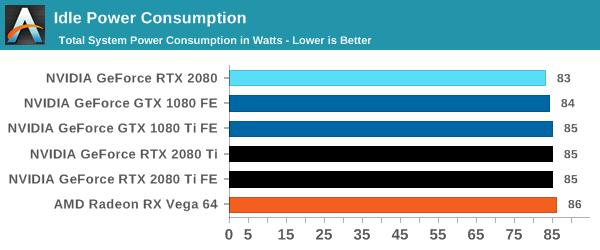
When we crank up a real-world title, all the RTX 20-series cards are pushing more power. The 2080 consumes 10W over the previous generation flagship, the 1080 Ti, and the new 2080 Ti flagship goes for another 50W system power beyond this. Still not as much as the Vega 64, however.
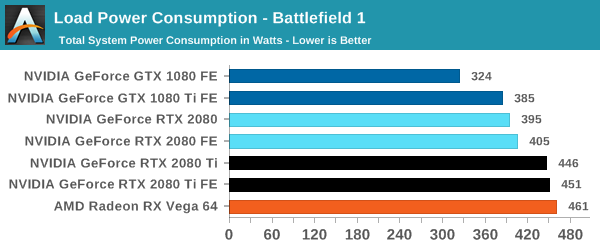
For a synthetic like Furmark, the RTX 2080 results show that it consumes less than the GTX 1080 Ti, although the GTX 1080 is some 50W less. The margin between the RTX 2080 FE and RTX 2080 Ti FE is some 40W, which is indicative of the official TDP differences. At the top end, the RTX 2080 Ti FE and RX Vega 64 are consuming equal power, however the RTX 2080 Ti FE is pushing through more work.
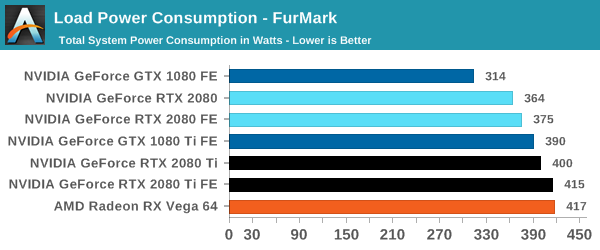
For power, the overall differences are quite clear: the RTX 2080 Ti is a step up above the RTX 2080, however the RTX 2080 shows that it is similar to the previous generation 1080/1080 Ti.
Temperature
Straight off the bat, moving from the blower cooler to the dual fan coolers, we see that the RTX 2080 holds its temperature a lot better than the previous generation GTX 1080 and GTX 1080 Ti.
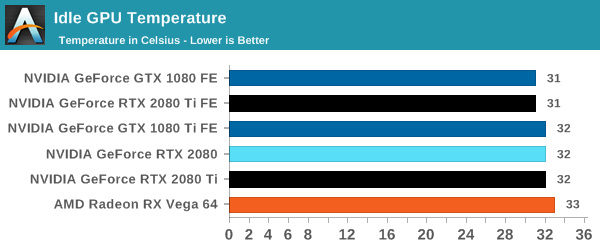
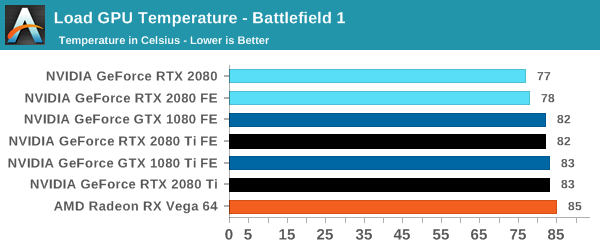
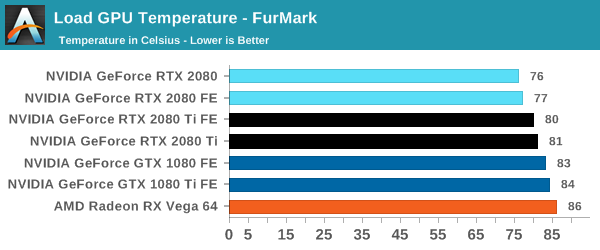
At each circumstance at load, the RTX 2080 is several degrees cooler than both the previous generation and the RTX 2080 Ti. The 2080 Ti fairs well in Furmark, coming in at a lower temperature than the 10-series, but trades blows in Battlefield. This is a win for the dual fan cooler, rather than the blower.
Noise
Similar to the temperature, the noise profile of the two larger fans rather than a single blower means that the new RTX cards can be quieter than the previous generation: the RTX 2080 wins here, showing that it can be 3-5 dB(A) lower than the 10-series and perform similar. The added power needed for the RTX 2080 Ti means that it is still competing against the GTX 1080, but it always beats the GTX 1080 Ti by comparison.
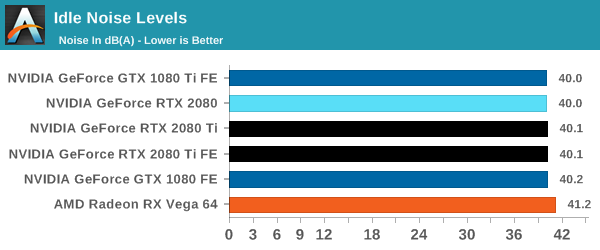
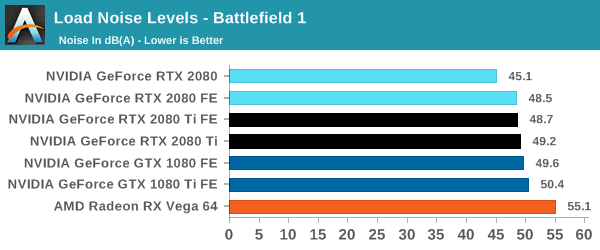
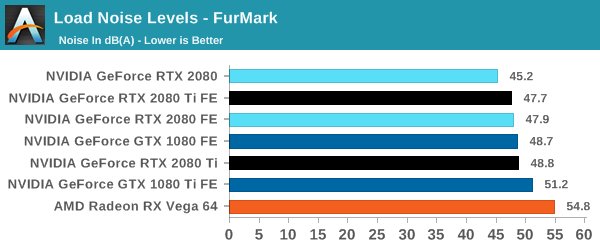










337 Comments
View All Comments
Spunjji - Friday, September 21, 2018 - link
If that were true then Nvidia could have left off the RTX parts this time around and created a GPU that offers a simple ~30% performance improvement at roughly the same retail cost.Following that, the die-area benefits from 7nm could have been spent on both RTX features and another ~30% performance boost at a similar or slightly-higher cost. By then they could probably have added enough resources to at least manage high refresh rates at 1080p, if not 2.5K
Instead they massively inflated their die for features that require you to accept resolutions and frame-rates that PC gaming left behind 6 years ago.
mapesdhs - Wednesday, September 26, 2018 - link
That last sentence is something I which tech sites would emphasise a lot more. It very much defines how those who normally buy into the higher tier tech now regard what they like doing and why. NVIDIA pushed hard to create the market for high-refresh gaming, 4K & VR, now suddenly they're trying to do an about-face. I can't see how it can work. I just bought a 27" 1440p IPS panel for 200 UKP, the cost of good screens has come down a lot, and now NVIDIA wants us to drop back down to 1080p? :D I get the impression the reaction of a great many is just laughter.Gastec - Thursday, September 27, 2018 - link
Ahaa! You are getting close :) Come on, just spell it: they want to "milk" us as much as possible before Moore's Law ends and we will completely stop upgrading our PC's and we'll just replace the defective part twice in a life time. No more billions of moneyz for Corporate Commander :)Yojimbo - Wednesday, September 19, 2018 - link
"Please, let's boycott Turing cards."Throw down your chains and resist!
Ranger1065 - Thursday, September 20, 2018 - link
100%Xex360 - Wednesday, September 19, 2018 - link
These cards are a disappointment for the price, the 2080ti should be priced at most 800$, it just doesn't offer the performance required for justifying its price, worse here they compared it to the 1080ti FE which as GamerNexus pointed out is not ideal, for the cards are noticeably slower than other cards with proper cooling, so the 1080ti is at least as fast as the 2080.On the ray tracing side, I like the technology but it's not impressive enough to justify the hefty price tag, I'd rather have a real generational leap with a 2070 beating a 1080ti and a 2080ti having at least 70% more performance than having RT, it's a niche product and obly few games will benefit from it, and the whole DLSS isn't good either limited to only a few games, with more brut force we could achieve 4k and super sampling.
kron123456789 - Wednesday, September 19, 2018 - link
"I'd rather have a real generational leap with a 2070 beating a 1080ti and a 2080ti having at least 70% more performance than having RT"That reminded me of a very old quote:
"If I had asked people what they wanted, they would have said ‘faster horses.’" — Henry Ford
saikrishnav - Wednesday, September 19, 2018 - link
That quote only makes sense if Nvidia came up with a "different" radical product than a graphical horse. They just made a slightly faster horse with a RTX ON button which nobody is ready to push yet i.e. developers. So, if you have a choice between a much faster horse and a RTX ON button - one would take a much faster horse. Now, when developers are ready to push the button/envelope, and sign on to the RTX, then this quote makes sense. Nvidia is asking customers to pay the price of new tech-adoption without show-casing the products that use it. They could have invested with devs and in games, to use the RTX, and then released it. But no, they want to fill in a gap until 7nm arrives.Yojimbo - Wednesday, September 19, 2018 - link
Nobody was ready to push the mass produced automobile button, yet, either. Do you think Ford started mass producing cars and then immediately there were roads and gas stations? No, at first horses could comfortably go many more places than cars could.His quote is entirely appropriate.
There is no gap to fill before 7 nm arrives since AMD will have no competition. NVIDIA introduced this now because they see value in the product which will generate sales. Plus it will get the ball rolling on developers implementing the new technologies that are present in the architecture and will be present in future NVIDIA architectures.
BurntMyBacon - Thursday, September 20, 2018 - link
Have to agree here. No only where automobiles extremely limited in where they could go on introduction, they were also very loud and considered disruptive to society with a large voice of opposition. These new cards at least have the benefit of being able to go anywhere their predecessors can while still enabling new capabilities.I very much agree that nVidia is using this architecture to "get the ball rolling" on the new tech. They are probably very much aware that sales of RTX cards will be lower until they can fit a meaningful amount of the new hardware resources into a mainstream chip. Though, given the size of the chips and typical associated yields, nVidia may still end up selling every chip they can make.